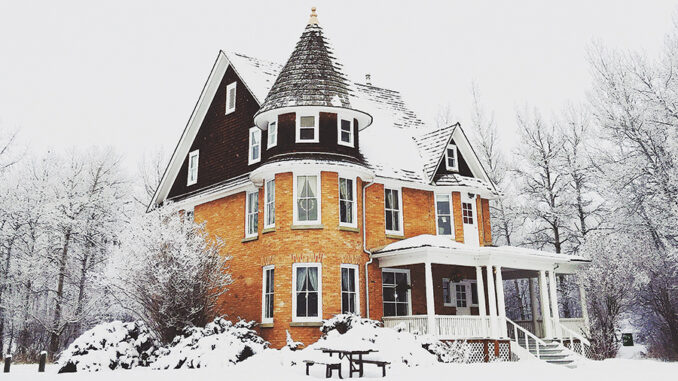
Winter is a wonderful time of year – but it can also be harsh on your home. The first freeze or the first snowfall isn’t the moment to start prepping your home for winter. That time is now, in fall, when you have plenty of time to make the right decisions and do the right things.
But how should you prepare your home for winter? Here’s a look at eight things homeowners should consider doing before winter arrives, as well as a bonus recommendation as you seek to make the most of these cold winter months.
1. Service Your Heating System
The last thing you want on a cold winter’s night is a faulty heating system. Winter can be an enjoyable and reflective few months, but only if your home is a warm and comfortable refuge from the cold.
So call your local heating and air conditioning company to schedule a maintenance appointment. During a maintenance visit, heating and cooling professionals can make sure your heater is ready to do its heavy lifting throughout November, December, January and February.
The pros can also identify emerging problems areas and make minor repairs – before those emerging problems turn into much larger and much more expensive emergency repairs during the heart of winter. If you use home heating oil, make sure your tank is full – and that you get on an aggressive refilling schedule.
2. Seal Around Windows and Doors
Windows and doors are notoriously leaky, allowing hot air to escape your home during wintertime. So go around to each of your windows and doors and look for loose screws, loose hinges and loose panels. Also, use caulk to fill in cracked or worn seals around your windows and doors. New caulk will help prevent hot air from leaking into the outdoors.

After you’ve sealed your windows and doors, use your window treatments to help keep warm air inside and cold air outside. When it’s overcast or dark outside, close blinds and draw curtains. This helps make your home more energy efficient. That said, when it’s sunny, even on the coldest days, consider letting that sunshine filter in through your windows to help naturally warm your home.
3. Check Your Attic
Hot air rises. We all learn that pretty early on. Which is why you need to check your attic and its insulation before winter sets in.
Without proper attic insulation, heat will escape from your home into the attic, which makes your heating system work harder while increasing your utilities bill. Also, proper attic insulation helps prevent dangerous ice dams, which form when snow and ice melt from one portion of your roof and then refreeze in another portion.
When ice dams form, they prevent water from draining properly off your home. Without proper drainage, water can seep into your roof, attic and ceiling – which are incredibly expensive issues to remedy.
4. Clear Your Gutters
As fall starts to turn into winter, spend an afternoon clearing leaves and other debris from your roof and gutters. If leaves and debris are left on your roof and in your gutters during the coldest months of the year, they can hamper your home’s drainage systems. That’s a bad thing when you’re dealing with precipitation (both frozen and not) during winter.
5. Drain Faucets, Wrap Pipes
If and when the temperature drops to 32 degrees Fahrenheit and below, water freezes. When water inside your pipes and faucets freezes, it expands those pipes and faucets – which can lead to cracking and serious plumbing issues.
There’s a simple way to prevent cracking and other ice-related plumbing problems. Before winter hits, disconnect water hoses from exterior faucets to allow drainage. On the coldest winter nights when your home experiences hard freezes, consider opening up cabinets where pipes are located inside the house, and drip each interior faucet to prevent water inside the pipes from freezing.
6. Fertilize Your Lawn
Here’s a pre-winter tip that few homeowners know about: Fertilize your lawn in late fall. Over the course of summer, your lawn is beaten and worn down by heat and a drop in precipitation levels. By fertilizing a lawn in late fall, the lawn’s root system will grow stronger and the increase in nitrogen levels will help your lawn come back strong when winter fades to spring.
In most parts of the country, it’s best to fertilize once in early September and then again in late October or early November. This double-shot of fertilizer is just what your lawn needs to rest and strengthen during the coldest months of the year.
7. Winterize Your Lawn Equipment
After you’ve fertilized your lawn equipment for winter, it’s time to store your lawn equipment for winter. Make sure that you drain the gasoline from your mower, trimmer, blower and any other tools that run on gas. Wipe down your equipment to prevent dirt and oil from causing corrosion.
Also, consider getting rid of any leftover gas you have in storage. Older gasoline can cause carburetor problems, which will cause engine starting and running problems, forcing your lawn equipment to work harder than it needs to.
8. Stock Up for Emergencies
Winter can be a time of serious and extreme weather events. Make sure that your home and the people living inside it are prepared to thrive if a blizzard or ice storm hits and keeps you inside for a length of time.
What should you have in case of winter emergency? Here’s a sample of things you can have on hand:
•A flashlight and additional batteries
•A battery-powered radio
•Drinking water
•Non-perishable food and snacks
•Candles and matches
•A first-aid kit
•Blankets
•Needed medications
You can add to this list based on where you live and your unique circumstances, but these items should give you a head start when creating an emergency kit.
Bonus: Prepare for Winter Fun
Wintertime can be the best time for you and your family. So make sure you have all that you need to enjoy these cold months to the greatest extent.
Create a fire pit in the backyard if you like to spend time outdoors. Add outdoor electrical outlets where you need them if you like to decorate at the holidays. Invest in sleds if you live near a hill where you can enjoy fresh snowfall.
Preparing your home for winter fun is also good if you need to sell your home during the coldest months. By creating enjoyable outdoor spaces and maximizing the wintertime entertainment value of your home, you demonstrate to potential buyers the full and active lifestyle that’s available at your home.
Is Your Home Ready for Winter?
As a real estate professional, I’m constantly talking to clients and prospective clients about making the most of their homes during the winter – including recommendations on how to protect their investments and how to maximize their homes’ values.
Is your home ready for winter? If you have any questions or would like expert guidance as you consider preparations and improvements, I’m always here to help. Get in touch with me at pthessen1@gmail.com.me at pthessen1@gmail.com.
-by Perry Thessen





